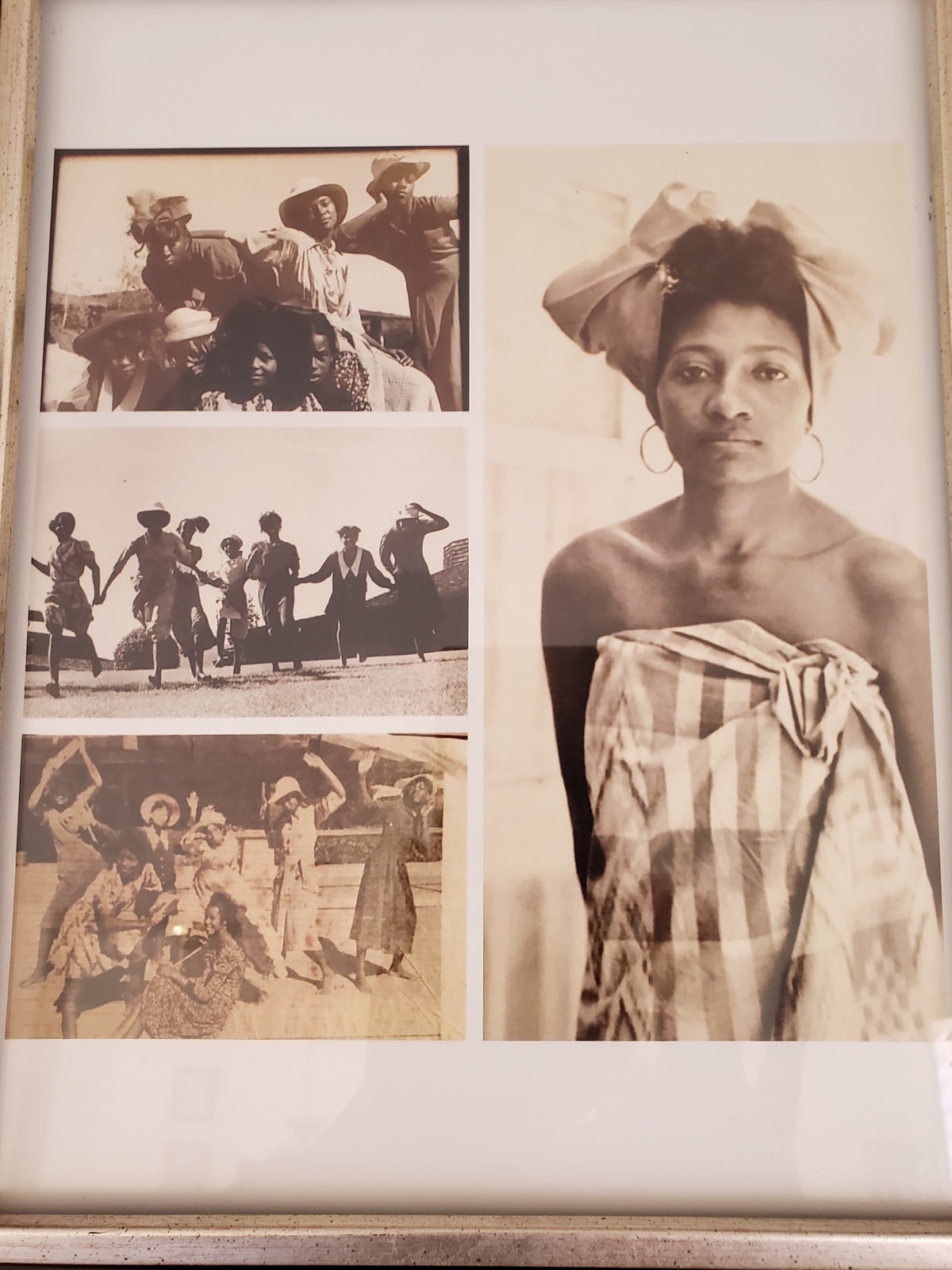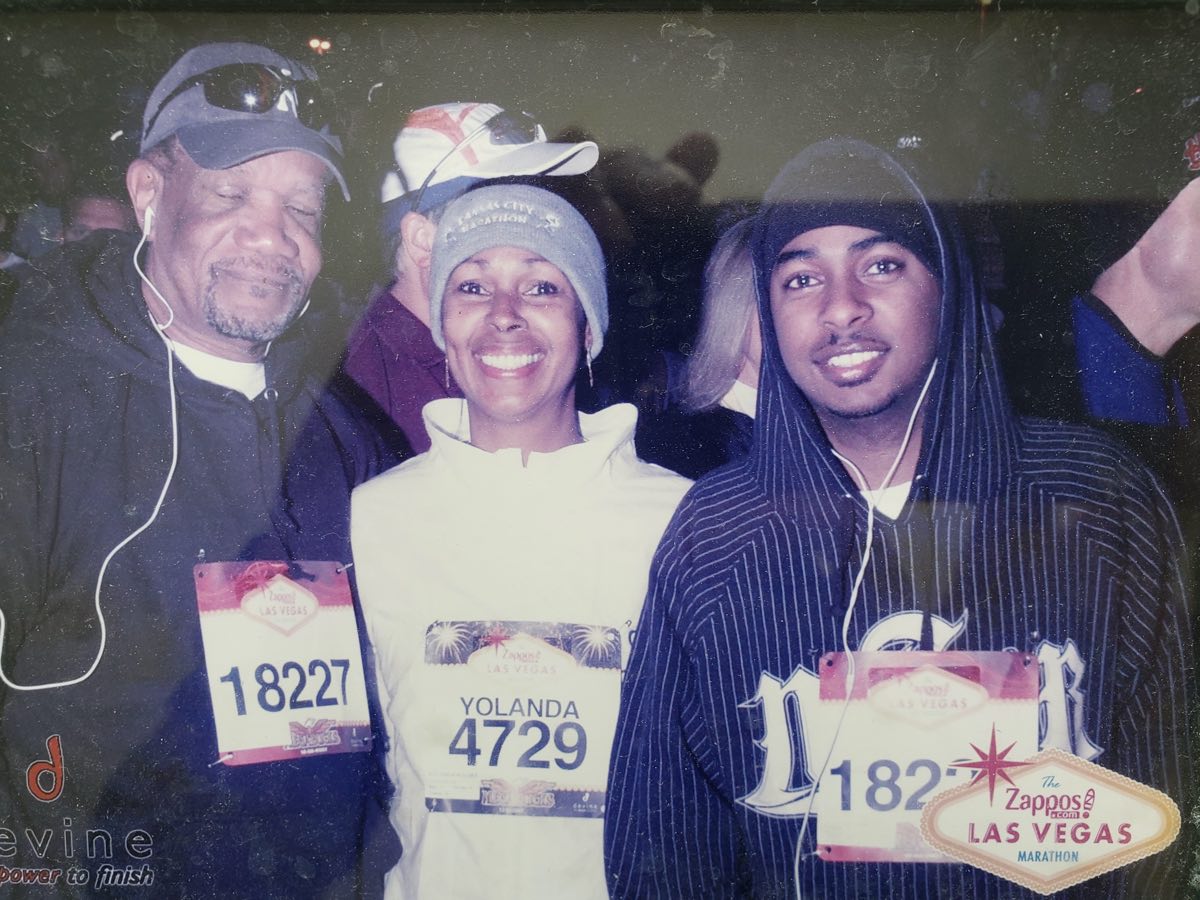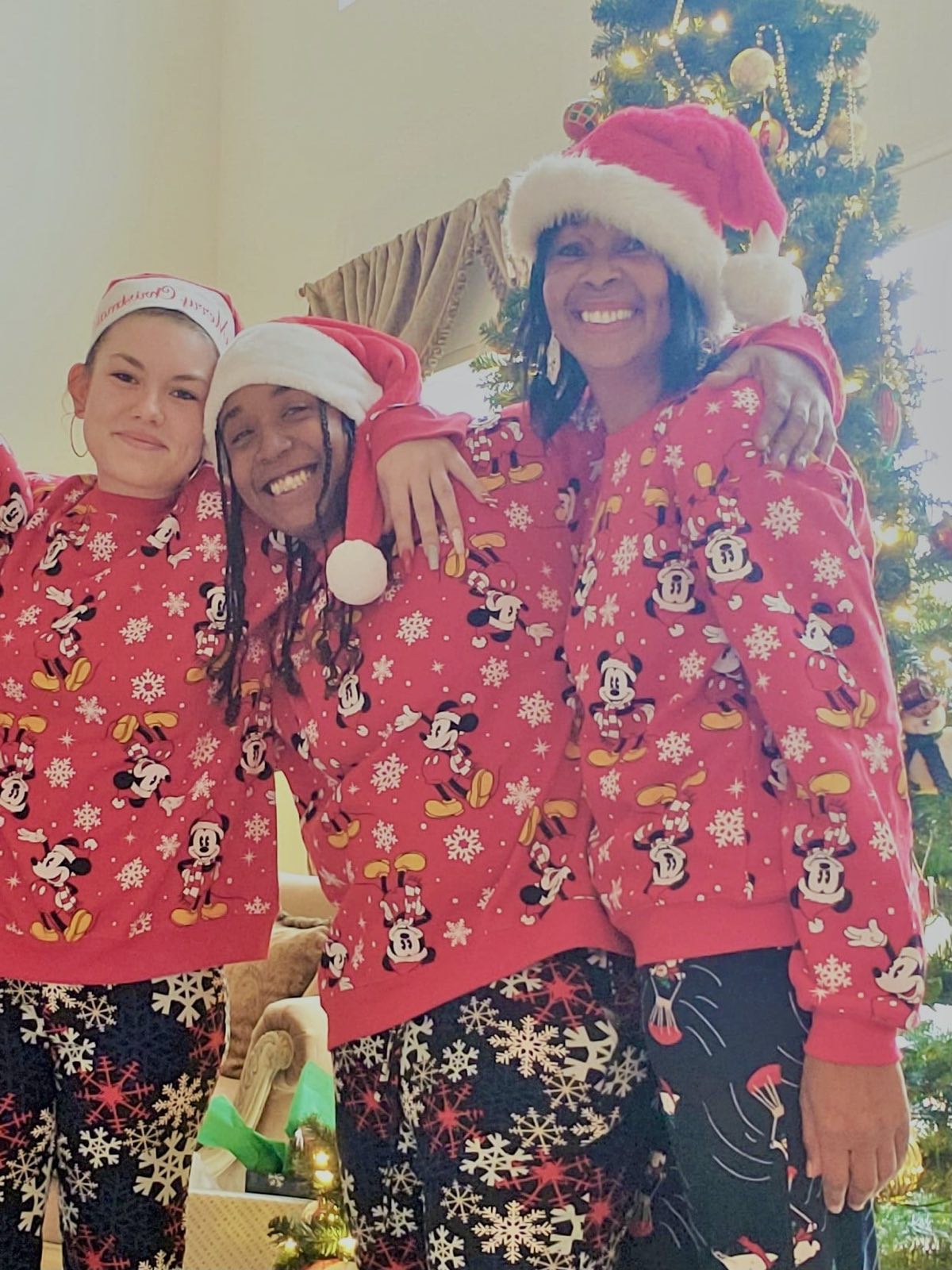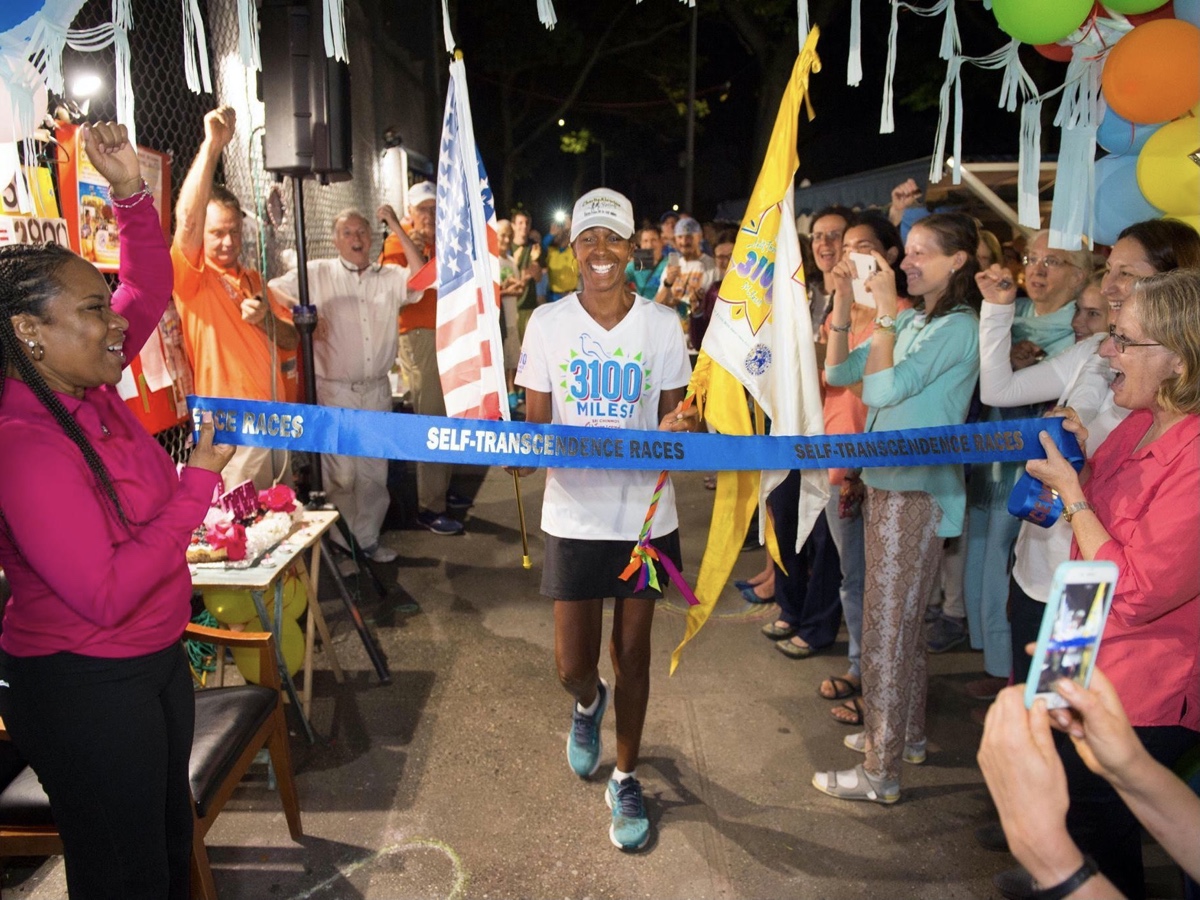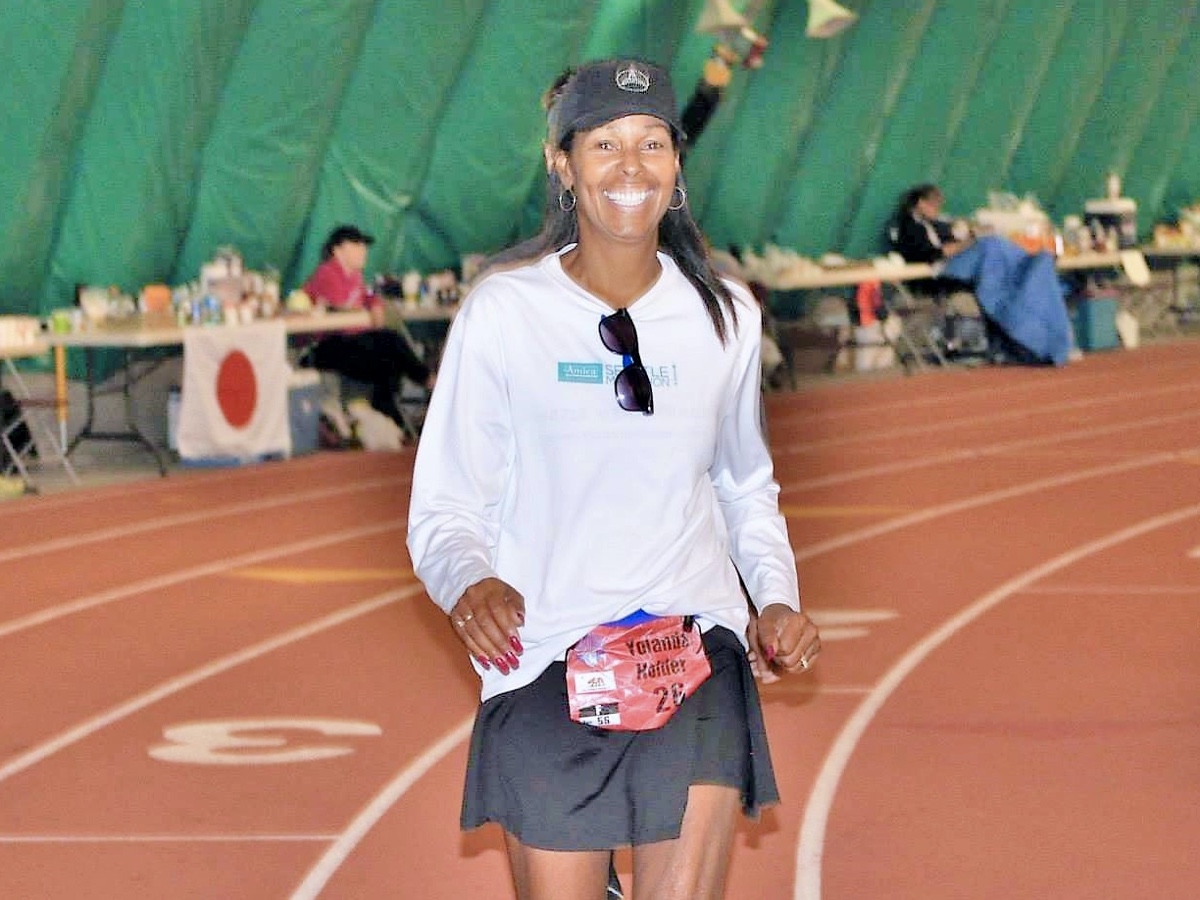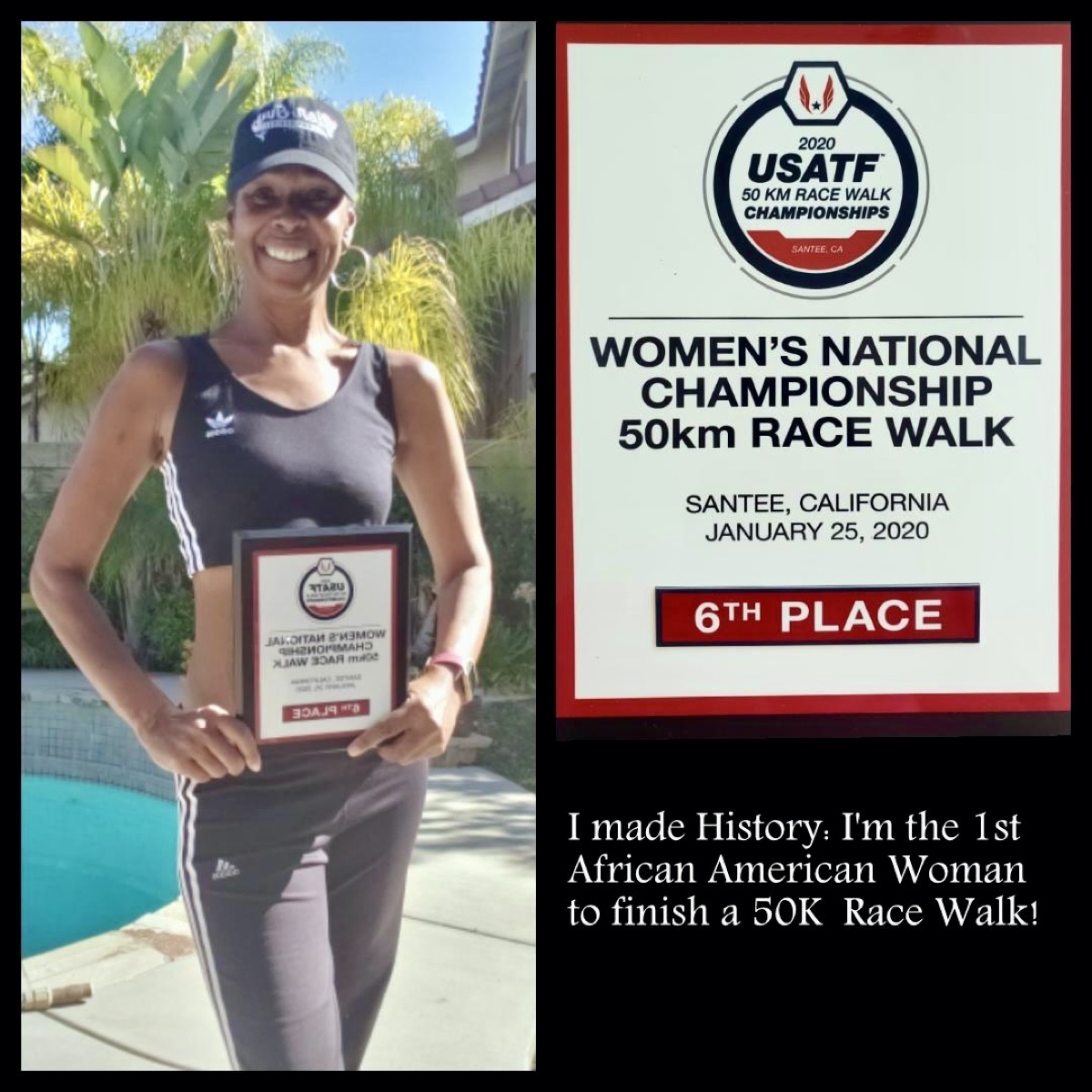Yolanda Holder is a master of a mighty technique that most trail runners and ultrarunners need for their longest races: powerwalking. Powerwalking is a fast-walking technique that is applied by ultramarathoners, marathon walkers, and other racers during organized events. Holder’s first race was the 1998 Portland Marathon, which she powerwalked.
Then 40 years old, she was immediately hooked. Holder loved exploring a new place, the crowd’s energy, the movement, and planning her outfit. “I wore a tennis skirt, designer sunglasses, and got my hair done straight down. I was paying $55 for the marathon, so why be miserable? Why not have fun and look good while you do it,” says Holder. It wasn’t long before she became a fixture in the sport, gaining her nickname as the Walking Diva.
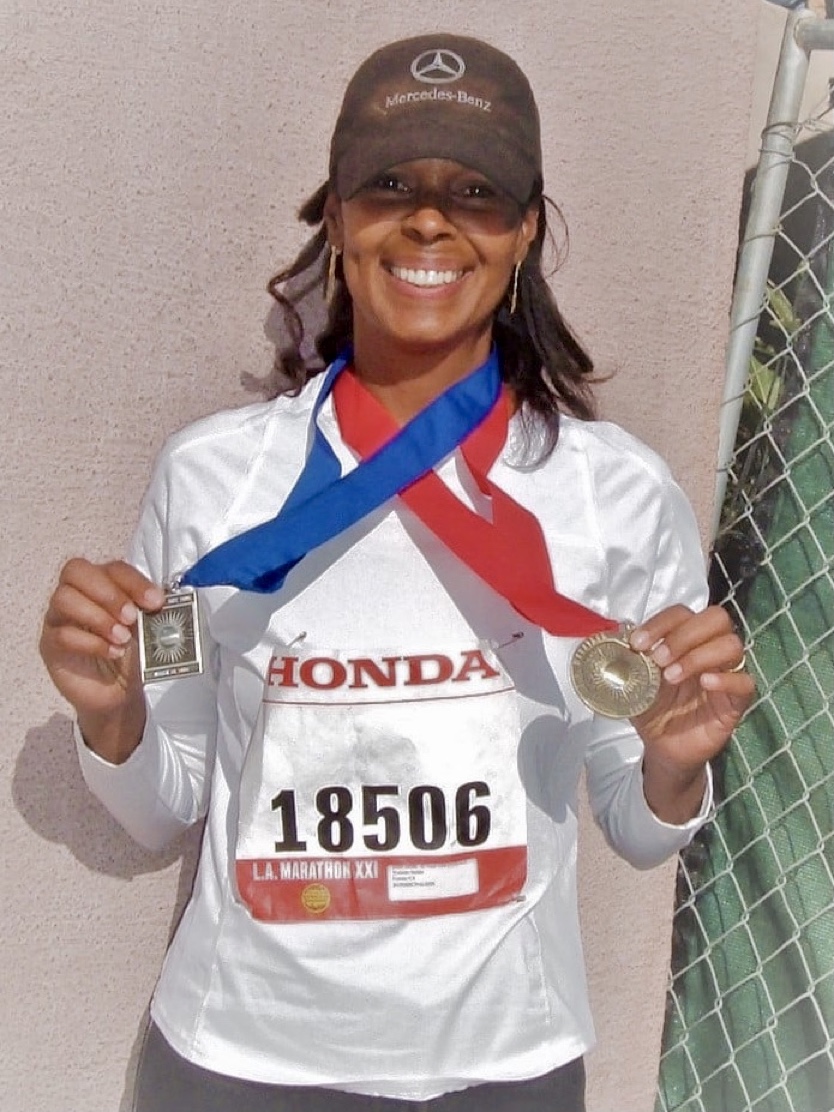
Yolanda Holder after finishing one of her first marathons, the Los Angeles Marathon. All photos courtesy of Yolanda Holder.
Eventually, her interest shifted to a more refined, advanced technique called race walking. Race walking is a specific sport with events and judges that hold athletes accountable to the sport’s structured technique. “I can now call my self a race walker. With powerwalking, you do your own thing. Race walking is the most brutal sport in the Olympics, because we are judged on form. When one leg hits the ground, the knee needs to be straight. You can race walk so fast that you’re lifting—you can only see it if you freeze the camera—but one foot needs to be on the ground at all times,” says Holder. One impetus to learning the specialty is that the USATF Hall of Fame acknowledges race walkers, and she’d like an opportunity to apply.
At 62 years old, Holder has so far powerwalked close to 544 marathons. She’s even set a Guinness World Record for “Most Marathons Completed in a Calendar Year” by a woman—twice. Holder bested her own record with 120 marathons in 2012. (The current record holder is Angela Tortorice with 129 marathons.) The accomplishment solidified her as the first American woman and African American to complete more than 100 marathons in a single calendar year—and the first woman in the world to do it twice. But she decided to make that second round harder: She sprinkled in thirty-five 50k races and three 100-milers, including the Javelina Jundred, each of which counted toward her record total since they far exceeded a marathon’s distance.
“That’s when I gained more respect as a walker, when I started doing more 100 milers. If you’re in the mountains, you can’t always run anyway. The average runner has to walk [sometimes]. I would never win a marathon as a walker—but I can as an ultramarathoner. Now, elite ultramarathoners ask me, ‘How do you powerwalk like that?’ because runners can’t run for six days straight,” Holder says.

Yolanda on her way to setting a then Guinness World Record for “Most Marathons Completed in a Calendar Year” by a woman.
Holder didn’t grow up running. She was raised in San Jose, on the southern shore of San Francisco Bay, California. She had 10 siblings and after her parents divorced, money was tight for her single mom. She made the gymnastics team but didn’t have the financial support to participate. Though, she performed in the historic Imani Dance Ensemble, the only African dance group in the Bay Area at the time, and danced modern, as well.
That said, she outshined her peers in 11th grade during the one-mile race in physical-education (PE) class. “My PE teacher said, ‘You’re a long distance athlete, you should come out for track and field and do the 800-meter or one-mile races.’ I said, ‘No! This hurt. I don’t want to run.’ Now here I am doing [races that last for] multiple days,” says Holder.
After high school, she worked for a while and then married her husband Roger at age 23. She dove into raising a family. “I had the white picket fence and was a stay-at-home mom. I enjoyed every minute of it. I never did sports, so I made sure my kids RJ and Tiffany did all the sports. I lived [vicariously] through that.” Now, Roger is a retired computer engineer. When their kids left the nest, Holder was reinvigorated to pursue her own athletic dreams. “I always put them before me and when they left and went to college, it was my turn,” she says.
In the beginning of her race journey, she registered for five or six marathons a year. A few seasons in, she met a member of the Marathon Maniacs club while powerwalking the San Francisco Marathon. That run community, plus the excitement of traveling around the country, motivated her to pursue more events. “I started racing every weekend, and it became a positive addiction. It got my endorphins kicking. I would usually do a 50k on the trails on Saturdays. Then, I would fly or drive somewhere to do a marathon on Sundays. There was a big focus on logistics: figuring out how to quickly go between the two locations and where to sleep. A lot of my marathon friends are my best friends today,” says Holder.
After hitting 500 marathons in 2014, her focus moved toward longer-distance events. A couple of her favorite long events include the Javelina Jundred for its character, costumes, and vibe as well as Six Days in the Dome for the incredible catered food. To date, she’s finished eight six-day, 400-plus-mile races—podiuming in each of them.
One of the most challenging events she has tackled is the 2017 Self-Transcendence 3,100 Mile Race. The race is held annually in Queens, a borough of New York City, New York. Competitors complete an average of two marathons per day between 6 a.m. and midnight, every day until they finish. The course circles a half-mile city block—so racers need to do more than 100 laps per day. It takes place in the heat of the summer.
“You need an inner spirit and to dig so deep. One night, I saw myself in front of me, in a pink skirt. I had to keep shaking my head and finally she went away. I was hallucinating. So, I said to myself, ‘Take me home, come on girl,’” says Holder. Despite doing the same exact lap, Holder says it was entertaining to observe New York City culture, an ultimate melting pot of people and sports. “The course went around a high school and on one side was this park with a playground for kids. There was a baseball field, cricket games, and a handball court.”
There were only 10 participants total and three were women. She stayed in a basement apartment, a five-minute drive from the start. The race attendants would pick her up at 5:40 a.m. each morning and drive her home at midnight. It became increasingly difficult to step into the car or to take a shower. Most nights, she’d roll around in discomfort or tears. The sleep deprivation forced her to hone her power-napping skills, too. During the days, she’d nap for 15 to 20 minutes and feel refreshed. She completed the race in 51 days, 17 hours, and 13 seconds, a record in the pedestrian/walking category.
That same year, Holder’s interested evolved into that more refined, advanced technique of race walking. For her, learning race walking hasn’t been straightforward or easy. She accomplished a marathon distance then tried a 5k and was disqualified. It took three attempts at the USATF 50k Race Walk National Championships for her to not get disqualified due to form. “A 50k is a hard distance to keep that form the whole time,” she says. She powered through in 2020, earning sixth place and becoming the first African American to finish the 50k race walk.
“Now that I know how to race walk, I use race-walk techniques in my powerwalking [for the regular races I enter]. I use some of the arm movements that give you more speed, so I combine them, depending on the event. In [actual] race-walking events, you have judges every 200 yards and need that form. At the USATF 50k Race Walk National Championships, it’s a one-mile loop and eight judges are on course and a ninth one is on a bike,” she says.
Her next race goals include establishing an American record and world record for the women’s 60-to-64 age group in 50k race walking. She also wants to set the American record and break the world record for race walking at the 6 Jours de France, a six-day running and race-walking event with judges, in France. Holder says: “The 6 Jours de France is a the only six-day race with a race-walk category.” Race walkers are required to maintain their form the entire time. The exception is that they can have soft knees rather than a completely rigid leg as they plant each foot. None of the six-day races that Holder has completed so far feature a race-walk category. Meaning, she powerwalked at those events and competed against ultrarunners who generally did a combination of running and walking.
“Claudie Bizard of France currently holds the women’s six-day race-walking record at 387 miles. The race was canceled for 2021, due to COVID-19. I will attempt to break Claudie’s record in April of 2022,” says Holder.
Usually Holder trains year-round, but when COVID-19 hit in 2020 and races were canceled, her body “went into shock,” she says. “My body was like, what are you doing? Recovery, what’s that? It gave me a chance to recover. I was still leisurely walking everyday at a 15- or 16-minute-per-mile pace for 10 or 11 miles, but I had been so used to constantly doing races.”
Holder’s secret to longevity is simple. “Move your body for 45 minutes at one time, daily. You have to move your body,” she says. A typical training day might include a one-mile warm-up, 10k of race walking at a 14-minute-per-mile pace, and a one-mile cool down. Afterward, she stretches and incorporates pilates. Some days, she does speed drills, race walking as fast as she can—around 8:42-minute-per-mile pace—for one minute followed by a recovery period, repeated 10 times.
With her second book, Misty Blue: 3100 Miles of Smiles and Pain, to be published soon, Holder hopes to help dissolve negative stigma around powerwalkers and race walkers, she says. “Runners can look down on walkers, feeling like they’re more superior. I’ve had joggers or slower runners catch up to me and make smart remarks. I’ve been pushed and told to get out of the way. We share the same road.”
Holder is also excited to help set the bar for the next generation of athletes. “The ladies in their forties are completely badass. I’m setting an example for those athletes as they get older. By the time they hit their sixties, they’ve gotta’ break Yolanda’s record.”
Call for Comments
Use the comments section to share your stories about Yolanda Holder!
